Project Log: Friday, March 9, 2012
The relocation of the VHF to the main helm panel
simplified the potential overhead electronics display
that I'd been considering by eliminating the need for
such significant depth to the box, which I'd thought
looked bulky and awkward. Now, I planned only for
slim instrument displays that didn't require 5" of space
behind the panel, which meant (I hoped) that the
arrangement would be better integrated.
That being said, there still was minimal clearance above
the center window in the pilothouse, and there'd be no
way to avoid the display extending slightly over the
window frame when all was said and done. However,
I thought this was an acceptable compromise.
The overhead display would include two 4" instrument
heads--a wind display and depth/multi display--as well
as the late addition of a small, inexpensive backup GPS.
For the secondary unit, I selected a Lowrance Mark 4 LCD
plotter (and fishfinder, though I'd not be using that
function) for several reasons: first, Lowrance is
part of the same parent company as Simrad, oriented more
towards the small boat and fishing marketplace, and I
thought it made sense to stick within the same family,
all the more so because the menu-driven functions were
so similar to those on my Simrad unit; second, the Mark
4 featured a compact size that I thought I could fit in
the overhead console, with a family resemblance to the
nearby instrument heads; finally, the price and
impressive features of this small LCD unit simply could
not be beat.
The Mark 4 features an internal antenna, which in years
not far past I never would have expected to work without
a clear view of the sky. But GPS technology has
advanced to the point that such antennas have superior
capabilities, and while I anticipated all along that I'd
need to connect the unit to an external antenna, I
tested the unit in the shop, without pointing it out the
window or to the sky (similar to how it would be aligned
in the pilothouse), and it acquired satellites and
position without issue, so there seemed a good chance I
could avoid the external antenna. |
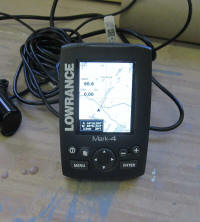 |
The Mark 4 was a bit taller than the other instrument
heads, but was generally compatible, and was about the
smallest GPS display available, not counting handhelds
(which I'd also have on board; my old Garmin 45 still
works). Still, this would require that the front
panel of the overhead console be about 6" in height,
perhaps an inch more than it would need to be for just
the instrument heads.
Earlier in the week, I'd prepared another panel with
plywood backing and black Kydex face, so having
determined the dimensions needed I milled it to its
final size, after which I built a couple blanks of solid
cherry that would eventually be the side panels.
For appearance and function, I intended the face to be
angled at 20°. The front panel would need to be
removable, so I milled rabbets in the side panels for
the front to recess into, and secured it with screws.
I temporarily clamped the still-oversized assembly in
place and marked the side panels where they met the
angled pilothouse forward so I could scribe them to fit. |
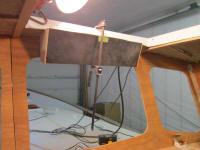 |
Cutting to these marks reduced the protrusion of the
assembly, and brought the face forward enough so that it
was just forward of the large overhead hatch/skylight
opening. The side panels, incorporating the 20°
angle, tapered down to nearly nothing at the bottom
(about 3/4" - 1"), but still overhung where the window
frame would eventually be, so I'd have to incorporate
the frame into the design of the panels somehow.
More on that later.
My first inclination had been to scribe the top of the
panel to match the overhead, but since that shape was
uneven, and since the panel naturally met the forward
edge of the hatch opening, I decided that trim would be
a better option, and wouldn't reduce the width of the
panel. |
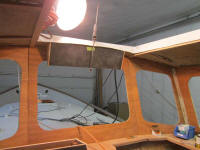
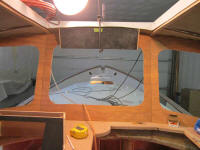
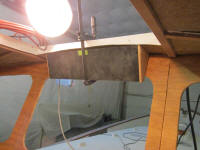 |
I thought the current arrangement would work (pending a
mockup of the window frame and incorporation thereof),
but to be sure I'd have adequate clearance for wiring
and installation of the actual electronics, I began to
lay out their positions on the panel. For access
and easier operation, I thought I'd put the GPS to
starboard, where it would be accessible from the
companionway, with the other instrument heads to port;
I'd finalize the spacing and layout later, but left it
here for the day. I expected to increase the
spacing between the instrument heads; the layout below
had them equidistant from the center of the panel, but
it seemed unnecessarily crowded, and the layout would be
necessarily asymmetrical no matter what I did.
|
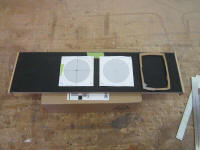 |
Meanwhile, with plans to work on various trim pieces
later in the weekend, I reassembled the various panels
of the helm console, and bunged the screw holes in the
lower console. I needed to keep various pieces
removable for future access, requiring exposed screws,
but the black-colored stainless screws looked much
better than the shiny ones I'd used earlier. |
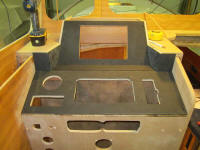
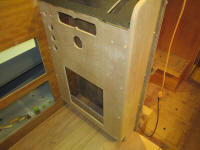 |
| |
Total Time Today: 4.5 hours
|
<
Previous | Next > |
|
|









